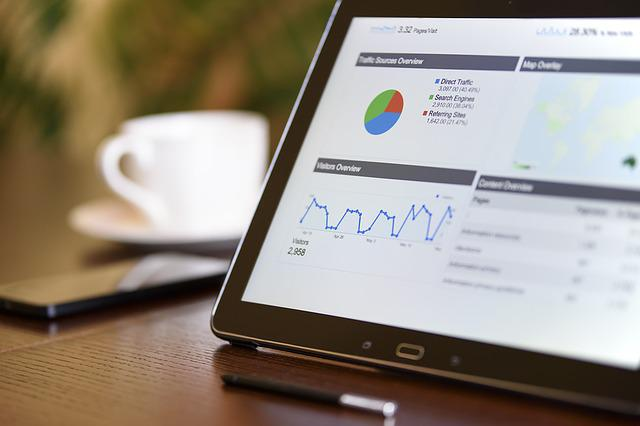The Simple Guide to B2B Buyer Persona Research
[ad_1]
The term “buyer persona” is popular among the consumer marketing crowd of agencies and experts. Most B2B businesses (especially small businesses) haven’t taken advantage of this powerful marketing tool.
In this article, I’m going to show you how any B2B business can do B2B buyer persona research to help you save tons of time, money, and marketing overwhelm so that you can target the right customers and close them easily.
What Is a B2B Buyer Persona?

A buyer persona is a semi-fictional representation of your ideal customer.
You create a buyer persona in order to better understand your target market, and to develop messaging that resonates with them.
The Key Difference Between B2C and B2B Buyer Personas

There are 3 key differences between B2C and B2B buyer personas.
- The decision maker. Typically a B2C buyer is the sole decision maker in a purchase. If the purchase is expensive, they may involve another family member. A B2B buyer is often part of a group that includes people from several departments.
- The sales cycle. B2C sales cycles are often much shorter than a B2B selling cycle which can take as long as 2 years. Again, if the consumer purchase is expensive such as a home or car, this will take longer.
- The purchasing process: Both B2B and B2C buyers go through a research process before making a purchase, B2B buyers gave to jump a higher justification hurdle in terms of budgets, ROI requirements, etc. before they commit to a purchase.
One thing you don’t see mentioned here is a difference in marketing campaigns or messages. Regardless of whether your target customers are businesses or consumers, they are all people who respond to emotional marketing messages.
What’s the Difference Between an Ideal Customer Profile vs. Buyer Persona
At the heart of every marketing strategy and all of your marketing efforts is your ideal customer. But what makes your ideal customer different from your buyer persona?
Your ideal customer is a general description of who will benefit most from your product or service.
But you buyer persona is a tangible document that you include as marketing of your marketing strategies, marketing campaigns, and marketing messaging that you share with your marketing team.
In the same way that you create product descriptions for your marketing materials, you will develop a buyer persona that represents your ideal customer.
Why You Need a B2B Buyer Persona
Building buyer personas will focus your marketing strategy, marketing campaigns and marketing messages in a way that will bring your ideal customers our of the woodwork.
Well developed buyer personas can help your salespeople identify and contact prospective customers who are part of your target audience, but may not have purchased. Target personas make finding and converting your target audience faster and easier. And that means a much shorter selling cycle.
What do you do with B2B buyer personas?
So, why should go to through the process of comprehensive market research on your ideal customers to come up with a persona? What are you going to do with this thing?
- Give it to your sales team and customer service teams. First, they’ll be able to match their existing customers to the persona’s you’ve developed and develop them further with more detailed information. Next, they’ll be able to identify potential customers based on the buyer personas you’ve shared.
- Share it with your marketing teams and agencies. The first question every marketing person will ask you is “who is your ideal customer?” or “Why do your ideal customer’s choose you, “what are their pain points”, or give me some buyer persona examples.
- Use your buyer personas to recruit focus groups. I know, focus groups sound expensive, but they aren’t. You can simply recruit prospects or customers based on the buyer personas you’ve created and dig deeper into what matters to them.
- Create social media groups. Just because you’re in a B2B business doesn’t mean that you can’t have a Facebook group. A good buyer persona can help you create a Facebook group based on interests, pain points, demographics or the biggest challenges that match your ideal customer.
B2B Buyer Persona Research Outline

Before I dig into the details of buyer persona research, I think it would really help to give you an outline of basic information about how research is organized and what type of data you can collect to build a profile of your ideal buyer.
The easiest way to think about customer data research is to divide your information into two categories; qualitative and quantitative data.
Qualitative data is “soft data” that can’t be easily quantified. For example, text from customer support tickets, responses to open ended questions, and interviews.
Quantitative data is numeric data such as survey data, profitability information, website analytics.
Getting a deeper understanding of what data points go where will help you come up with a buyer persona that will grab your ideal audience’s attention.
Quantitative data

Here is a list of quantitative data that you can collect as part of your buyer persona research.
Google Analytics for Keywords and Language use
Too many people ignore website data, but it’s the best true measure of customer behavior. Simply collecting the search terms that your best leads use to find your company will give you voice of the customer language that you can use to create content.
Marketing Automation Data (Click Rates, Conversions)
Your email data is another source of primary research that tracks how your customers move through your sales funnel. With the onset of Web 3, your email open rates are no longer a good measure. Instead, focus on click rate data. Which customers click on what links.
CRM Scoring and Engagement
Many CRM tools offer a scoring feature that will help you identify your best customers. Here’s how that works. You can assign a score (anything you want it to be) for every action your customer or prospect takes.
The highest scoring customers are those who are most engaged and closest to making a purchase. You can use scoring to choose respondents for customer surveys, identify happy customers, or those customers who may need more information to buy from you.
Social Listening to Identify Questions and Concerns
Social listening is when you watch what people are saying on social media about your company or products. You can find out what people are asking about your products and what they don’t like. This way, you can fix any problems that people have before they become bigger problems.
Quizzes, Surveys and Polls to Help Segment
One of the best ways to start collecting quantitative data about B2B buyer personas is to create a series of quizzes, surveys or polls. This will help you gather deeper insights into what your potential customers or existing customers think, feel, and choose the way they do.
Existing Customer Purchasing Data
You already have a ton of customer purchasing data, You can use this data to identify your best customers.
With a list of your best customers in hand, you can start looking for similarities and differences which you can use to create your personas.
Frequently Asked Questions
Aside from the frequently asked questions that you’ve come up with yourself, reach out to customer service and ask them to keep track of the questions customers ask them.
Channels and Information
First you want to find out where your qualified leads go for information. Once you have a decent and representative list, you can monitor those channels, participate in those channels and start getting an idea of how they make purchasing decisions.
First you want to find out where your qualified leads go for information. Once you have a decent and representative list, you can monitor those channels, participate in those channels and start getting an idea of how they make purchasing decisions.
Buying process and purchasing decisions
It’s important to understand the step by step process your customers use to choose your product or service.
Qualitative research

Goals and Motivation
Yes, even a B2B buyer has goals and motivations that go beyond their work. They are people too. And your best customers are those who feel connected to you and your company, no matter what the company size.
Understanding the goals and motivations of your target personas will drive more than 80% of new business.
Problems and Fears
The other side of understanding goals and motivations is understanding your best customers’ pain points, problems and fears.
Marketing is all about understanding these pain points and creating marketing strategies that your sales team can use to connect with customers.
Personality Traits
Identifying your buyer’s personality traits will take some in depth research. Don’t be afraid to reach out to your sales team or customer service group. They are the ones who have more frequent conversations with your customers.
Obstacles
Obstacles are nothing more than getting an understanding of what gets in the way of your ideal customer’s ability to achieve their ideal outcome.
Influences
Influences are all the elements that drive your customer’s decision-making. These are often hidden beneath the facade of professional conversations.
Sometimes these influences are personal, other times they are professional, but still others are beliefs and values.
Another way to look at buyer influences is to think about what people, experts or companies get your audience’s attention. Do your best to understand what it is about these influences that are relevant to your buyer persona.
A Day in Their Life
Proctor and Gamble is best known for their highly advanced customer research. One type of research they do often is called “observational” research.
This type of observational research involves watching their customers in their “natural habitat” — how they engage with their products. That type of understanding really helps them understand exactly what their customers go through every day and how that relates to their product.
Success Factors
Success factors are those elements that your customer thinks is going to make them the most successful. These can be almost anything.
Barriers to Purchase
This one is pretty obvious. What are the things that get in the way of customer’s making a purchase decision. Don’t just think about budget, consider looking for other people involved in the decision, it can also be something as simple as not seeing the “buy” button.
Shopping Preferences
Speaking of “buy” buttons. How do your customers like to buy? Do they prefer the physical experience? Do they prefer to buy online? Do they purchase alone or do they make the decision with someone else. There can be even more subtle preferences, and that’s the goal of doing this research with your B2B buyer persona.
The Purchase Process
What process do your potential buyers use to get from not knowing a thing about what they are looking for to finding and purchasing what you’re selling.
Instead of mapping out how you want them to move through the process, see how they actually do it.
Who to Interview When Researching B2B Buyer Personas

Whether you want new business or just to get a complete look at your personas so you can effectively market to them, you’ll need to interview these three segments.
Current customers and past customers
Select your best and favorite customers. Make sure you also0 take note of their demographic data in additional to any professional data.
Potential Prospects
Another segment you want to interview is potential customers. Do this after you’ve interviewed your current customers.
Industry influencers
Industry influencers will help you gain persona insights. These are people who have a lot of sway in your industry, such as bloggers, reporters, and analysts. They can provide great insights into what’s happening in your industry and what trends are taking shape.
Other Referrals
As you’re conducting interviews, be sure to ask for any referrals from your sales teams, marketing team or anyone else who can give you an in-depth look behind the schenes of your customer base.
Tips on recruiting people to interview for your B2B buyer personas
1. Ask customers and prospects directly if they are willing to participate in a brief interview about their thoughts on your company and products.
2. Use social media platforms, such as LinkedIn, to identify individuals who have made or are in the process of making a purchase from your company.
3. Reach out to current and past customers.
4. Collaborate with other businesses who share your target market to identify individuals who would be willing to participate in an interview.
5. Use online tools, such as Google Forms or SurveyMonkey, to create a survey that can be sent to current and past customers, as well as potential prospects.
Now that you have some qualitative data to work with, it’s time to start looking at quantitative data. This will help you understand the numbers behind your B2B buyer persona research.
List of Sample Questions for B2B Buyer Persona Research
I’ve pulled together a list of questions that you can use for your market research.
Demographic Information Questions: About Them
- What is the average age of your customer persona?
- What’s their gender identification (if any)?
- Do they have children? If they do, how many and what are their ages?
- What is their marital status?
- Where do they live?
- What is their income level?
- What is their education level?
- What’s their occupation?
- What is their job title and/or primary role?
- What’s their career path like?
- What industry do they work in?
- How big is the company they work for?
- What special skills do they have?
- What tools do they use to do their job?
- Who do they report to?
- Do they manage others?
- How is their success measured?
Goals and Challenges: What are they trying to do and what’s getting in their way?
- What are their professional goals and aspirations?
- What’s the ideal outcome they are looking for?
- What challenges and obstacles get in their way?
- What job are they looking to get done?
- What events might trigger them to look for a solution for their problem?
Values and fears around products and services they use in their work
Perhaps the most important category to understand for your buyer profile is found in what they value and what they fear.
- What do they value? What values do they espouse?
- What’s important to them when they are buying what you’re selling?
- What would get in the way of them purchasing your product or service?
- What criteria would they use to choose this product or service?
- Which alternatives (if any) might they consider?
- What are the consequences of choosing the wrong product or service?
- What are the consequences of doing nothing or leaving things as they are?
Buyer Persona Habits
How can we reach these people? This section will help you figure out which social media channels to use, where to publish your content, and which conferences you should attend.
- How does your buyer get information?
- What magazines do they read (both professional and personal)
- How do they prefer to communicate (email, text phone, etc)?
- What media do they consume (cable, newspaper, social, other)?
- What clubs, organizations or associations do they belong to?
- Where do they spend most of their time on social media?
- What types of conferences or events do they attend (personal and professional)?
- What’s a typical day look like??
- What are their hobbies?
Buyer Persona Templates
WOW! This sounds like a lot to consider! Are there any templates and tools that can help you profile your potential buyers?
You Bet — and here’s a list of the best buyer persona templates and tools that I could find.
- Basic Document Template
- HubSpot Make My Persona
- Up Close & Persona
- Smaply
- Live Persona by Delve AI
- Mnemonic AI
- Uxpressia
- Xtensio
- Personapp
- Delve.ai
- SEMRush Buyer Persona Template
- Persona Generator
- Involve.me Persona Quiz Generator
- UserForge
- Xeerpa
- RockContent
You might want to play around with several of these tools and see which one works best for you.
What’s Next?
Now that you understand the importance of B2B buyer persona research, it’s time to start doing some market research. Check out our guide on how to do market research for your business to get started.
[ad_2]
Source link
